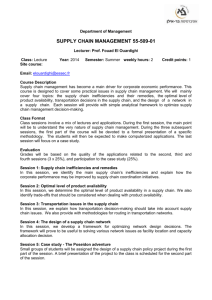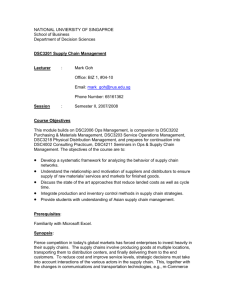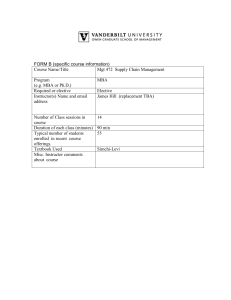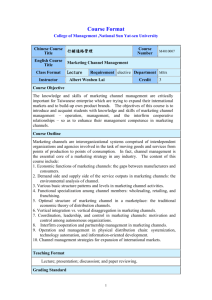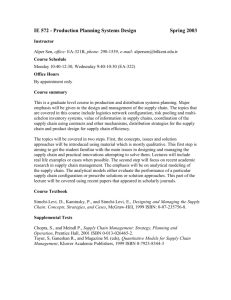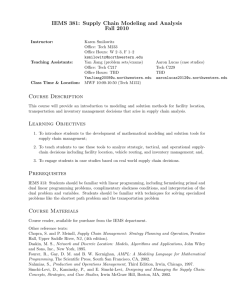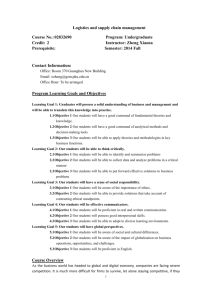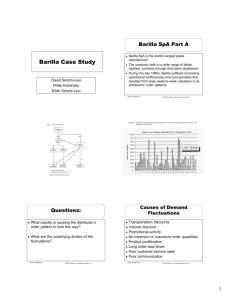Introduction to Supply
advertisement
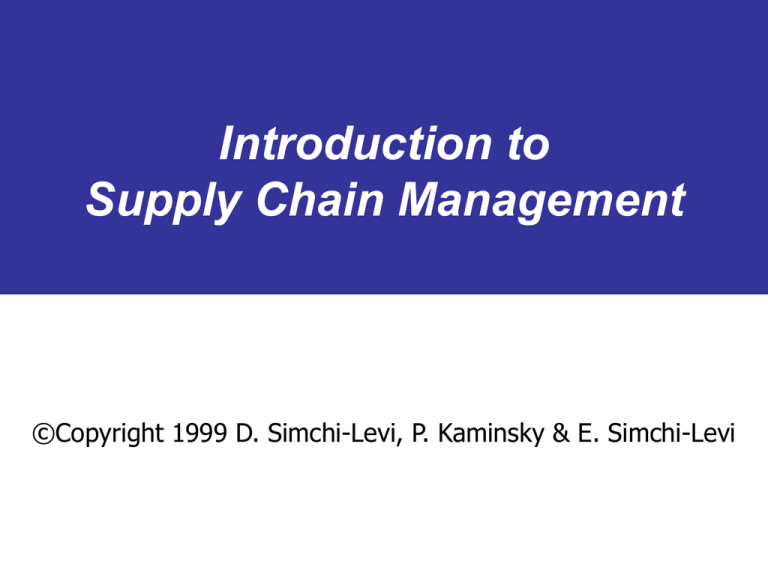
Introduction to Supply Chain Management ©Copyright 1999 D. Simchi-Levi, P. Kaminsky & E. Simchi-Levi Sources: plants vendors ports Regional Warehouses: stocking points Field Warehouses: stocking points Customers, demand centers sinks Supply Inventory & warehousing costs Production/ purchase costs Transportation costs Inventory & warehousing costs Transportation costs Supply Chain Management • Definition: Supply Chain Management is primarily concerned with the efficient integration of suppliers, factories, warehouses and stores so that merchandise is produced and distributed in the right quantities, to the right locations and at the right time, and so as to minimize total system cost subject to satisfying service requirements. • Notice: – Everyone is involved – Systems approach to reducing costs – Integration is the key ©Copyright 1999 D. Simchi-Levi, P. Kaminsky & E. Simchi-Levi Conflicting Objectives in the Supply Chain 1. Purchasing • Stable volume requirements • Flexible delivery time • Little variation in mix • Large quantities 2. Manufacturing • Long run production • High quality • High productivity • Low production cost ©Copyright 1999 D. Simchi-Levi, P. Kaminsky & E. Simchi-Levi Conflicting Objectives in the Supply Chain 3. Warehousing • Low inventory • Reduced transportation costs • Quick replenishment capability 4. Customers • Short order lead time • High in stock • Enormous variety of products • Low prices ©Copyright 1999 D. Simchi-Levi, P. Kaminsky & E. Simchi-Levi Order Size The Dynamics of the Supply Chain Customer Demand Distributor Orders Retailer Orders Production Plan Time Source: Tom Mc Guffry, Electronic Commerce and Value Chain Management, 1998 ©Copyright 1999 D. Simchi-Levi, P. Kaminsky & E. Simchi-Levi Order Size What Management Gets... Customer Demand Production Plan Time Source: Tom Mc Guffry, Electronic Commerce and Value Chain Management, 1998 ©Copyright 1999 D. Simchi-Levi, P. Kaminsky & E. Simchi-Levi Volumes What Management Wants… Production Plan Customer Demand Time Source: Tom Mc Guffry, Electronic Commerce and Value Chain Management, 1998 ©Copyright 1999 D. Simchi-Levi, P. Kaminsky & E. Simchi-Levi The Dynamic Supply Chain • Increasing customer power leads to increased demands on retailers • Increased retailer power leads to increased demands on suppliers ©Copyright 1999 D. Simchi-Levi, P. Kaminsky & E. Simchi-Levi Supply Chain: The Magnitude • In 1998, American companies spent $898 billion in supply-related activities (or 10.6% of Gross Domestic Product). – Transportation 58% – Inventory 38% – Management 4% • Third party logistics services grew in 1998 by 15% to nearly $40 billion ©Copyright 1999 D. Simchi-Levi, P. Kaminsky & E. Simchi-Levi Supply Chain: The Magnitude • It is estimated that the grocery industry could save $30 billion (10% of operating cost) by using effective logistics strategies. – A typical box of cereal spends more than three months getting from factory to supermarket. – A typical new car spends 15 days traveling from the factory to the dealership, although actual travel time is 5 days. ©Copyright 1999 D. Simchi-Levi, P. Kaminsky & E. Simchi-Levi Supply Chain: The Magnitude • Compaq computer estimates it lost $500 million to $1 billion in sales in 1995 because its laptops and desktops were not available when and where customers were ready to buy them. • In 1993, IBM lost a major fraction of its potential sales of desktop computers because it could not purchase enough chips that control the computer displays. ©Copyright 1999 D. Simchi-Levi, P. Kaminsky & E. Simchi-Levi Supply Chain: The Magnitude • Boeing Aircraft, one of America’s leading capital goods producers, was forced to announce writedowns of $2.6 billion in October 1997. The reason? “Raw material shortages, internal and supplier parts shortages…”. (Wall Street Journal, Oct. 23, 1997) ©Copyright 1999 D. Simchi-Levi, P. Kaminsky & E. Simchi-Levi Supply Chain: The Potential • Procter & Gamble estimates that it saved retail customers $65 million through logistics gains over the past 18 months. “According to P&G, the essence of its approach lies in manufacturers and suppliers working closely together …. jointly creating business plans to eliminate the source of wasteful practices across the entire supply chain”. (Journal of Business Strategy, Oct./Nov. 1997) ©Copyright 1999 D. Simchi-Levi, P. Kaminsky & E. Simchi-Levi Supply Chain: The Potential • In two years, National Semiconductor reduced distribution costs by 2.5%, delivery time by 47% and increased sales by 34% by - Shutting six warehouses around the globe. - Air-freighting microchips to customers from a new centralized distribution center. ©Copyright 1999 D. Simchi-Levi, P. Kaminsky & E. Simchi-Levi Supply Chain: The Potential • In 10 years, Wal-Mart transformed itself by changing its logistics system. It has the highest sales per square foot, inventory turnover and operating profit of any discount retailer. • Laura Ashley turns its inventory 10 times a year, five times faster than three years ago. This is achieved by using - New Information System - Centralized Warehouse ©Copyright 1999 D. Simchi-Levi, P. Kaminsky & E. Simchi-Levi Supply Chain: The Potential “For a company with annual sales of $500 million and a 60% cost of sales, the difference between being at median in terms of supply chain performance and in the top 20% is $44 million of additional working capital.” -- PRTM Director Mike Aghajanian ©Copyright 1999 D. Simchi-Levi, P. Kaminsky & E. Simchi-Levi Supply Chain: The Complexity National Semiconductors: • Production: – Produces chips in six different locations: four in the US, one in Britain and one in Israel – Chips are shipped to seven assembly locations in Southeast Asia. • Distribution – The final product is shipped to hundreds of facilities all over the world – 20,000 different routes – 12 different airlines are involved – 95% of the products are delivered within 45 days – 5% are delivered within 90 days. ©Copyright 1999 D. Simchi-Levi, P. Kaminsky & E. Simchi-Levi Supply Chain: The Complexity 1. Supply Chain Integration • Conflicting Objectives • The Dynamics of the Supply Chain 2. Matching Supply and Demand 3. System Variations over Time 4. Status of Logistics Knowledge • Many problems are new • Incomplete understanding of issues • Methodology is rather narrow ©Copyright 1999 D. Simchi-Levi, P. Kaminsky & E. Simchi-Levi ISSUES: Decision Classification • Strategic Planning: Decisions that typically involve major capital investments and have a long-term effect. 1. Determination of the number, size and location of new plants, distribution centers and warehouses 2. Acquisition of new production equipment and the design of working centers within each plant 3. Design of transportation facilities, communications equipment, data processing means, etc. ©Copyright 1999 D. Simchi-Levi, P. Kaminsky & E. Simchi-Levi ISSUES: Decision Classification • Tactical Planning: Effective allocation of manufacturing and distribution resources over a period of several months 1. Work-force size 2. Inventory policies 3. Definition of the distribution channels 4. Selection of transportation and trans-shipment alternatives ©Copyright 1999 D. Simchi-Levi, P. Kaminsky & E. Simchi-Levi ISSUES: Decision Classification • Operational Control: Includes day-to-day operational decisions 1. The assignment of customer orders to individual machines 2. Dispatching, expediting and processing orders 3. Vehicle scheduling ©Copyright 1999 D. Simchi-Levi, P. Kaminsky & E. Simchi-Levi ISSUES: Why Keep Inventory? • Uncertainty in customer demands • Uncertainty in the supply – Uncertainty in quantity and quality – Uncertainty in delivery time – Uncertainty in costs • Economies of scale ©Copyright 1999 D. Simchi-Levi, P. Kaminsky & E. Simchi-Levi ISSUES: Demand Forecast • The three principles of all forecasting techniques: – Forecasting is always wrong – The longer the forecast horizon the worse the forecast – Aggregate forecasts are more accurate ©Copyright 1999 D. Simchi-Levi, P. Kaminsky & E. Simchi-Levi ISSUES: Inventory control • • • • How much inventory to keep? Can uncertainty be reduced? What size should orders be? How does forecasting tool effect inventory level? ©Copyright 1999 D. Simchi-Levi, P. Kaminsky & E. Simchi-Levi ISSUES: The Challenge of Inventory Management • Matching supply and demand accurately is a critical challenge – “Dell Computers predicts a loss; stock plunges. Dell acknowledged that the company was sharply off in its forecast of demand, resulting in inventory writedowns”. (WSJ, August 1993) – “IBM continues to struggle with shortages in the Think Pad line”. (WSJ, May 1994) – “Liz Claiborne said its unexpected earnings decline is the consequence of higher than anticipated excess inventories”. (WSJ, August 1993) ©Copyright 1999 D. Simchi-Levi, P. Kaminsky & E. Simchi-Levi ISSUES: Purchasing • What to Purchase - In-house production Vs. external suppliers • Where to purchase - Domestic Vs. international • From whom to purchase - Cost - Reliability: quality and on time delivery - Availability and flexibility ©Copyright 1999 D. Simchi-Levi, P. Kaminsky & E. Simchi-Levi ISSUES: Purchasing • Centralized Vs. Decentralized • Number of suppliers: Single sourcing Vs. Multiple sourcing • Supply contracts ©Copyright 1999 D. Simchi-Levi, P. Kaminsky & E. Simchi-Levi ISSUES: Production • Location of manufacturing plants – Production cost – Taxes – Incentives (by government) – Proximity to markets and raw materials – Transportation infrastructure – Political stability and culture ©Copyright 1999 D. Simchi-Levi, P. Kaminsky & E. Simchi-Levi ISSUES: Production • Flexibility – The ability to produce different products simultaneously and efficiently – The ability to produce new products efficiently ©Copyright 1999 D. Simchi-Levi, P. Kaminsky & E. Simchi-Levi ISSUES: Production • Efficiency – Low cost – Short lead time • Reliability – On-time delivery – Quality ©Copyright 1999 D. Simchi-Levi, P. Kaminsky & E. Simchi-Levi ISSUES: Distribution • The structure of the distribution network • The distribution strategy – The Classical Strategy – Cross Docking – Direct Shipping ©Copyright 1999 D. Simchi-Levi, P. Kaminsky & E. Simchi-Levi ISSUES: Product Design • What role does product design play in supply chain management? • When is redesigning products worth the cost? • Can product design compensate for uncertainty in customer demand? ©Copyright 1999 D. Simchi-Levi, P. Kaminsky & E. Simchi-Levi ISSUES: Information Systems • The advantages of advanced information systems • The challenge of unlimited data • The roll of e-commerce • Impact of the internet ©Copyright 1999 D. Simchi-Levi, P. Kaminsky & E. Simchi-Levi ISSUES: What’s New in Logistics? • Global competition • Shorter product life cycle • Increasing product variety • New, low-cost distribution channels • More powerful well-informed customers ©Copyright 1999 D. Simchi-Levi, P. Kaminsky & E. Simchi-Levi ISSUES: What’s New in Logistics? • New communications and information technologies POS and EDI technology – Wireless technology • Decision Support Systems • Integrated systems • Multi-modal transportation ©Copyright 1999 D. Simchi-Levi, P. Kaminsky & E. Simchi-Levi ISSUES: What’s New in Logistics? • New concepts in logistics – Push Vs Pull strategies – Cross docking – Strategic alliances – Manufacturing postponement – Design for Logistics ©Copyright 1999 D. Simchi-Levi, P. Kaminsky & E. Simchi-Levi
